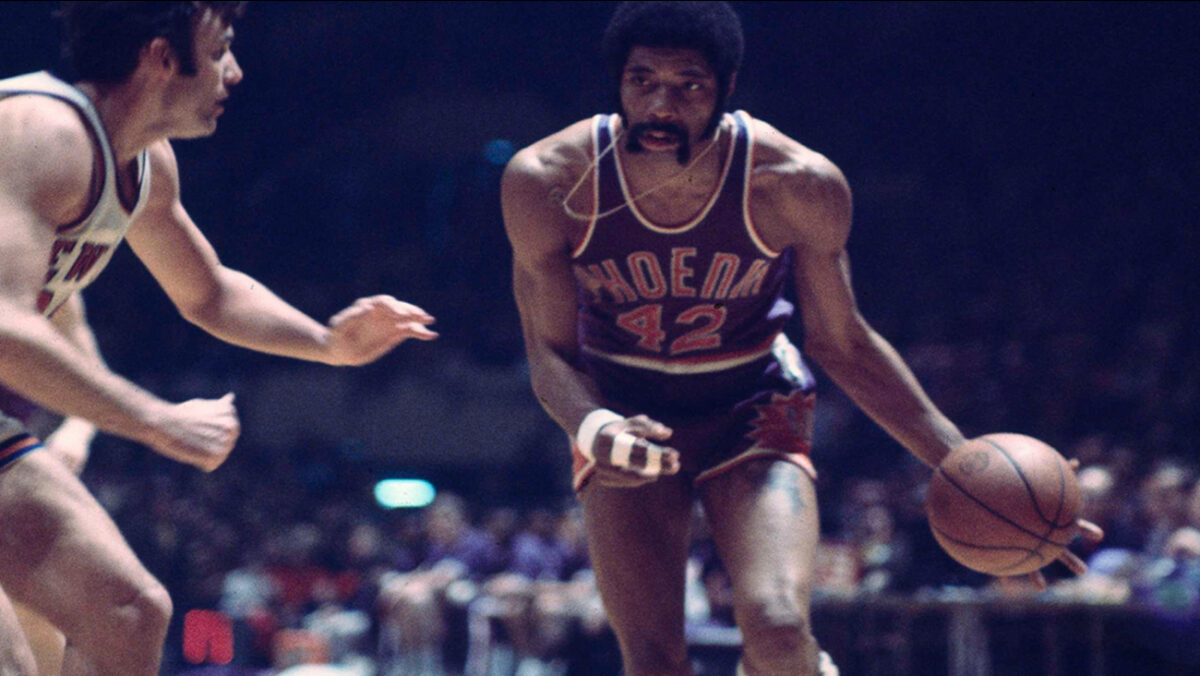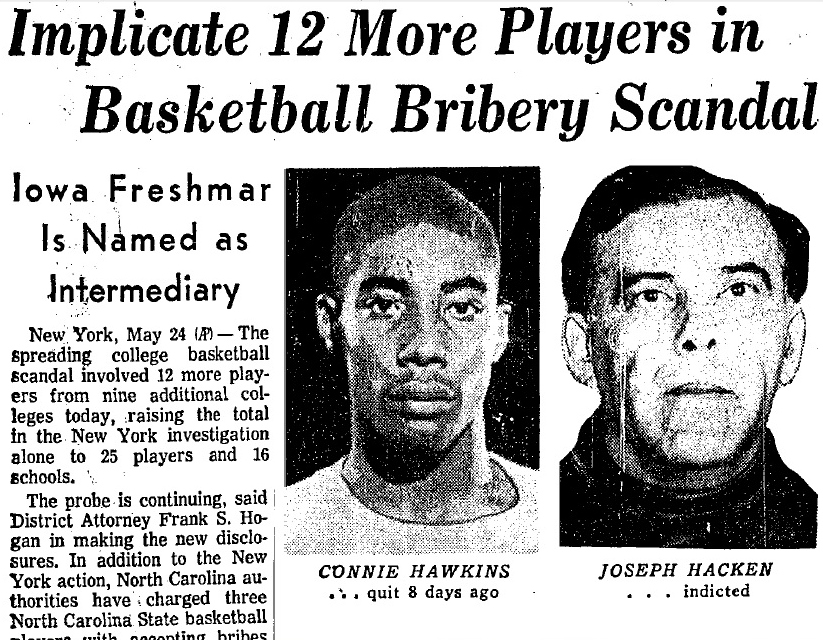
Connie Hawkins, a beloved New York City playground star, revolutionized basketball with his flamboyant style, creativity, agility, and talent. Hawkins’s incredible performance and flair were followed by future greats like Erving and MJ who copied his spectacular game and attitude.
Both on and off the court, his flashy game packed houses all over the nation thanks to his Fu Manchu mustache and enormous hands, as well as his seeming ease with which he controlled the basketball.
Hawkins was awarded Most Valuable Player of the now-defunct ABL (American Basketball League) in his only season at Pittsburgh. An ABL legend, he immediately got picked up to the All-Star Team.
From 1964 through 1966, Hawkins played for the Harlem Globetrotters, where he was an outstanding player. When he hung up his sneakers, Abdul-Jabbar included Hawkins among his top 15 opponents he’d ever faced or teamed with.
After finally getting to play in the NBA, he was picked up by the Phoenix Suns where he shined like a star.
Connie Hawkins – Early life
Hawkins was born into abject poverty in Brooklyn. Basketball became an outlet for him when he was younger; it wasn’t until his junior year of high school that he really began to focus on the game, and he soon established himself as a Brooklyn blacktop basketball legend.
He was able to pick from any number of colleges because his well-mixed blend of height, athleticism, and elegance was nearly unprecedented.
Connie Hawkins – College career
Hawkins began attending the University of Iowa in 1960 and, as was the custom at the time, had to spend a year on the freshman team. Hawkins did not disappoint Iowa students when they watched him play. However, everything came crumbling down before anything substantial had begun afterward.
Legal troubles
Prior to his freshman year with the university, he would, occasionally, take advantage of his relationship with the former NBA player Jack Molinas, something that would prove to be one of the worst decisions of his life. Molinas was wound up in a match-fixing scandal in college basketball. He had built an imperium of a sizable proportion.
Soon enough, after authorities found out about Hawkins’ relationship with him, he had to leave for New York where he would be interrogated by the law. Because of that, he remained undrafted and banned from the NBA indefinitely, even though there wasn’t any solid proof of any unlawful doings by Hawkins.

Following the case, Hawkins was left without a home and went on to wander around different, less-than-impressive, basketball teams. He was way too good for his opponents.
Connie Hawkins – Professional Career
Shortly after his expulsion from the University of Iowa, he chose the Pittsburgh Rens as his team, where he spent a year. The league, ABL, was a short-lived ordeal and lasted only a year. Nevertheless, he was named the MVP of the season. The level he would play at was more than sufficient for the NBA, but, unfortunately, at the time, he couldn’t be drafted due to his case.
Connie Hawkins – Harlem Globetrotters
In the newly-formed league’s second season, it fell apart and Hawkins was picked up by the Harlem Globetrotters, which were an American exhibition team. That time wasn’t much of a development for him, but, as he stated, he needed money to keep himself afloat.
He spent four years with the Globetrotters, during which time, he decided to sue the NBA for $6 million due to unjust proceedings by the league’s officials. While his case was strong as there wasn’t any sufficient evidence, he couldn’t participate in the NBA. For this reason, he went with the ABA, as suggested by his lawyers, so as not to lose his playing skills due to inactivity. Hawkins was able to prove himself as a great player, a feat that would pay off in the future.
Connie Hawkins was one of the best in the world, but the NBA wouldn’t let him play.
— Cycle (@bycycle) July 17, 2018
So he sued, got $1.3 million, and ended up in the Hall of Fame. pic.twitter.com/eBpoRTjcCN
Connie Hawkins – Pittsburgh/Minnesota Pipers
Following that decision, he decided to join the ranks of the Pittsburgh Pipers for the first season of the new league ABA. While the league was still making its baby steps, experts stated that there was lots of potential in its young players. After all, the American Basketball Association, despite its youth, was considered a professional league, unlike the ABL.
During his first year, Hawkins was a scoring and rebounding machine, which allowed the Pipers to get to the playoffs after a 54-24 record in the regular season. His averages of almost 27 points per game and over 13 rebounds. After plowing through both the Indiana Pacers and Minnesota Muskies in three and four games respectively, he had his first chance for a championship.
Even though the New Orleans Buccaneers managed to lead the series 3-2 after five games, the Pipers fought their way through Game 6 and 7 and edged out the Buccaneers, and won the title.
Pittsburgh Rens’ owners had their own contacts, and through them, he met a pair of lawyers, Roslyn and David Litman, who decided to take his case and go to court.

During his rookie year, he got a pass to the ABA All-Star team, led the league in scoring, and was second in field accuracy with his .519. At the season’s end, he also took the MVP Award home.
After the team relocated to Minnesota, Hawkins had a bittersweet year there. Due to knee surgery, he only played in 47 games. Still, he mustered up over 30 points and 11.4 rebounds, placing him second and fifth in the ABA. Once again, he was chosen to the ABA All-Star Team.
The Hawks moved to Minnesota the next year, and Hawkins played just over half of the season. In 47 games he averaged 30.2 points (second in the ABA to the Oakland Oaks’ Barry) and 11.4 rebounds (fifth in the league), shooting .503 from the field. He was named an All-ABA selection for a second consecutive season.
Connie Hawkins – NBA career
Finally, Hawkins’ time has come. After the Litmans won his case and got him total clearance of all charges, officials decided that he would join the Phoenix Suns for the 1969-70 campaign. Even though he was already 27 at the time, he would prove himself numerous times on the court.
Connie Hawkins – Phoenix Suns
Hawkins’ previous years got him quite a bit of media coverage and he was a known and well-respected player. He now had a chance to make a name for himself against the big dogs of the NBA.
In his rookie year, he played all but one game and managed a 24.6 point per game average for sixth place in the NBA. Topping the charts of the Suns, even with amazing players in the likes of Gail Goodrich and Dick Van Arsdale, he was immediately seen as a prodigy.
Along with scoring abilities, Connie Hawkins had other talents. His rebounding was also no joke – he got 10.4 rebounds per game and dished out almost five assists per game. Once again, he got the All-Star honors, this time for the much more powerful NBA.
His next two years weren’t all that great, but he still managed respectable averages of 20.9 and 21 points per game.
Connie Hawkins – Los Angeles Lakers
In 1973-74, after playing a couple of games, he joined the ranks of the Los Angeles Lakers, whose players were now nearing the end of their careers. With Wilt Chamberlain and Jerry West aging and hindered by injuries, the Lakers’ prime days were over.
Connie Hawkins vs. Phoenix suns
— Hoop History (@H00PHISTORY) February 2, 2022
Highlights his crazy long first step and finesse shot making ability.
1975 Regular Season pic.twitter.com/A7aoFjrJw1
Hawkins was seen as a new hope for the team, but he didn’t come through with any great numbers. His scoring dipped considerably to 12.6 points per contest. The next season wasn’t any better and Hawkins finished his bout with the Lakers with only 8 ppg in 43 games.
Connie Hawkins – Atlanta Hawks
His next move, this time to Atlanta, didn’t improve his numbers. Connie averaged just over 8 points per game and called it quits. His overall averages for his time in the NBA were 16.5 points per game and 19.3 during the playoffs.
Connie Hawkins (past his prime) pours in 20 PTS, 8 REB, 3 AST, and 1 STL.
— Hoop History (@H00PHISTORY) August 12, 2021
Phoenix Suns vs. Atlanta Hawks
December 25, 1970 pic.twitter.com/5588tFRBZS
Connie Hawkins – Naismith Memorial Basketball Hall of Fame
His showmanship was largely responsible for his election to the Hall of Fame. Hawkins was the first player to display the flair and a cool head that would later be exhibited by players such as Erving and Jordan. His induction also acknowledged that not all of basketball’s greatest moments were played on NBA courts.
The most beautiful ball was played in dimly lit community centers and on blacktop courts with chain nets, where players used to wear masks. That’s when Connie Hawkins made his name. He had just enough gas left to validate the claims that people had made about him by the time he got to the NBA.
What happened Connie Hawkins?
Being diagnosed with colon cancer in 2007, he died on Oct. 6, 2017, and was in poor health for years prior. He was a community representative for the Phoenix organization many years after his retirement as an original member of the Suns’ Ring of Honor.
VIDEO: Suns fans, friends, family remember Connie Hawkins pic.twitter.com/TRguLraoxx
— azcentral (@azcentral) October 21, 2017
Did Connie Hawkins have kids?
Connie Hawkins and his wife, Nancy, had two kids. They married in the late 1960s and settled in Phoenix, where Connie worked for the Suns as a community relations representative. Once he retired, they continued to live in Phoenix. Connie Hawkins was a great basketball player and an even better father. His children always looked up to him and admired his work ethic. Even after he retired from basketball, he stayed involved in the game by working for the Suns organization. He was a beloved figure in Phoenix and will be dearly missed by all who knew him.
How good was Connie Hawkins?
Connie Hawkins was an incredible basketball player from an early age. As a junior, he made First All-City Team and helped Boys to an undefeated season and the PSAC Championship. As a senior, at 6 feet 6 inches, and 190 lbs, he averaged 25.5 points and had a second undefeated season and a second Public School Athletic Championship.
However, despite his impressive skills on the court, Hawkins was not recruited by any of the major college basketball programs. This was due, in part, to his tall and lanky frame; at 6 feet 6 inches, he was considered too skinny to compete at the next level. Nevertheless, Hawkins persevered and went on to have an illustrious career in professional basketball.





